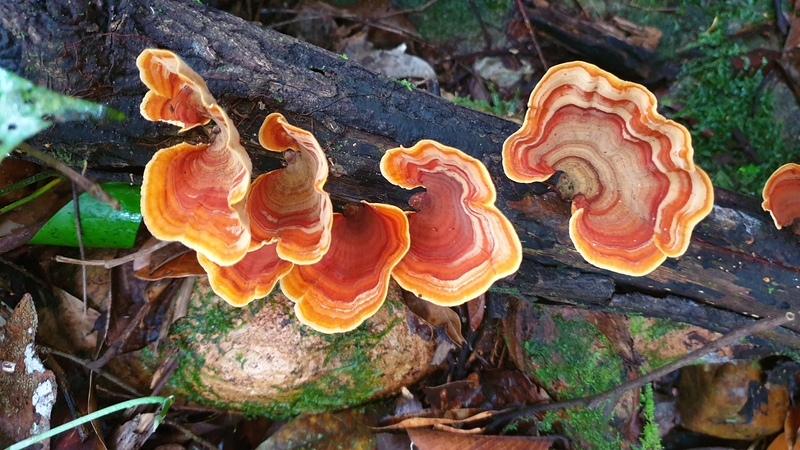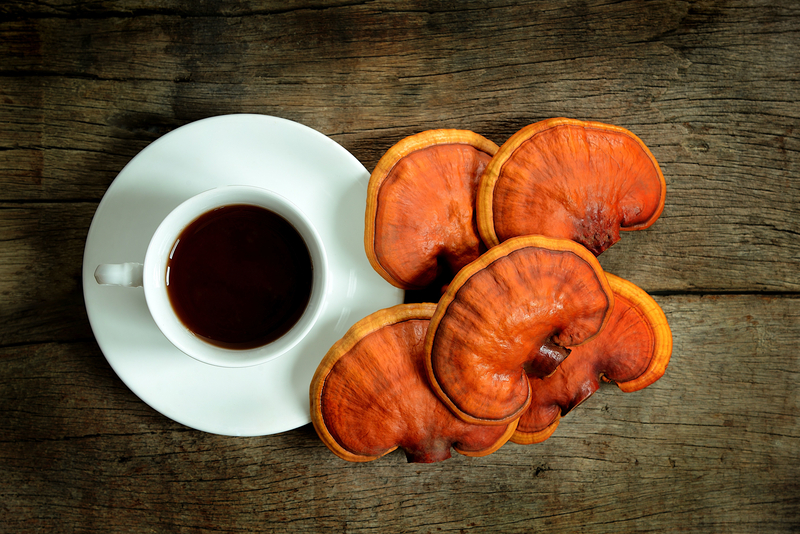Everything You Need To Know About Red Reishi Mushroom
General Information
Scientific Name: Ganoderma lingzhi / Ganoderma lucidum
Any Other Names: Reishi, Ling Zhi, Munnertake, Sachitake, Youngzhi, “Mushroom of Immortality”
Primary Constituents: Polysaccharides (Beta-Glucans, Coumarin, Mannitol, and Alkaloids), Fungal Immunomodulatory Proteins (FIPs), Ganoderic Acids, Triterpenoids
Country or Region of Origin: Native to Asia, Europe, and North America
Known Uses: Anti-Fatigue, Mood Booster, Antioxidant and Stress Reducer, Immune System Booster, Hearth Health, and More

General History & Introduction
Red Reishi Mushrooms are native to China, most of Asia, and scattered amongst comparable climates throughout the world. Although extremely rare, they are easy to spot with their bright red or orange-hued, clam-shaped glow protruding from a tree. These mushrooms are well-known and trusted constituents of traditional Chinese medicine. In fact, some common Chinese folklore glorifies the Reishi mushroom as the “Mushroom of Immortality,” where it is known as Ling Zhi and has been utilized for thousands of years (Knechtges, 1996). The primary reason the Red mushroom was nicknamed the Mushroom of Immorality is due to its purported anti-disease properties, fighting and preventing most major diseases of modern times (Paterson, 2006). And while the mushroom has many traditional uses, today it is easier to implement into a daily regimen as a nootropic extract.
Nootropic Benefits of Red Reishi Mushroom
Anti-Fatigue
Despite the fact the mushroom is known throughout traditional Chinese culture as the “Mushroom of Immortality,” the Red Reishi is well-revered for its anti-fatigue effects on the mind and body (Wachtel-Galor et al., 2011). There are many bioactive constituents which may contribute to the mushrooms longevity and energy-preserving properties including nucleosides, peptides, phenolic compounds, polysaccharides, and triterpenoids (Geng et al., 2017). And although more research is still required to determine which types of fatigue and energy the mushroom may impact, many studies prove it clear that Red Reishi offers relevant energy boosting effects (2017).
Antioxidant and Overall Cognitive Health

Many traditional and modern applications of Red Reishi involve its stress relieving properties. It is also revered for its positive effects on cognitive health. The antioxidant effects are part of the reason the mushroom is considered a general longevity herb (Cor et al., 2018). The proteins, lipids, phenols, sterols, and other bioactive compounds offer the mind and body very therapeutic effects (2018).
Mood Booster
Red Reishi Mushroom is commonly used for its mood boosting effects. It is sometimes used to fight depression (Socala et al., 2015). There are studies which suggest the herb can moderate mood, anxiety, and even seizure threshold (2015). Many studies propose that the mushroom’s water soluble extract has the potential to antagonize the 5-HT2A receptors which could help moderate anxiolytic-like effects toward many cognitive functions which contribute to mood (Matsuzaki et al., 2013).
Other Benefits

Red Reishi contains many bioactive components such as adenosines, flavonoids, peptides, polyphenols, and triterpenoids (Geng et al., 2017). These components are responsible for many of the obscure, positive effects of the mushroom. For example, Red Reishi can be found as an ingredient in many immune system support supplements. The mushroom is also notoriously used to promote cardiovascular function and overall heart health. Part of the gains seen by the cardiovascular system are from the energy provided by the mushroom (2017). There are some Chinese medicinal recipes with Red Reishi which are used to control blood sugar (Winska et al., 2019).
Although there is not enough empirical research available to reach a conclusion, there is some evidence which suggests that Red Reishi Mushroom may have anti-cancerous and anti-disease properties (Paterson, 2006). It has been shown to relieve blockages and pressure in the bladder. And other traditional applications of the herb are preparations meant to support respiratory health (2006).
Dosing and Usage Information
The fruiting bodies are where the Red Reishi offers most of its medicinal and culinary properties. These are the orange-colored parts of the mushroom exposed and visible on the surface of the tree. While these mushrooms have been foraged and consumed for thousands of years for their intrinsic value, they are commonly consumed as a healthy, purified extract via supplement. The typical Red Reishi Mushroom dose is around 500 mg per serving, per day of extract. These extracts may be anywhere from 1:2 to 1:20 in strength, with the dose varying depending upon the strength of the extract.
Side Effects
People with liver disease or liver conditions are advised to avoid Red Reishi Mushroom. The mushroom is generally considered safe for consumption within established daily values. Still, however rare, possible side effects may include dryness of the mouth, dryness of the nasal passageways, itchiness, rash, nausea, dizziness, headache, and diarrhea.
Other Important Information

Traditional use of Red Reishi in some cultures meant brewing the herb into an aromatic herbal tea or consuming dried or crushed preparations (Corbley, 2020). Today, the herb is more commonly consumed as an extract. And because there are many different extracts available, it is important to consider the quality and potency of the extract (some are stronger than others).
Conclusion
Red Reishi Mushroom has long proven itself throughout many traditional Eastern medicines. In modern times, the mushroom is making an impact in Western healing as well, appearing in many studies and journals as of late. The mushroom can be commonly found in longevity-based nootropic stacks and anti-fatigue/fitness supplements. Whether it is used for one of its more specific effects or as an overall health booster, it is a sensible addition to almost any daily regimen.
A Note from NooFiles
This article is intended to be used for information only. We want to remind you that consulting your physician is recommended before adding any dietary supplement of any kind to your daily regimen.
Sources:
Cör, D., Knez, Ž., and Knez Hrnčič, M. (2018). Antitumour, Antimicrobial, Antioxidant and Antiacetylcholinesterase Effect of Ganoderma Lucidum Terpenoids and Polysaccharides: A Review. Molecules (Basel, Switzerland). Vol. 23(3). Pp. 649. DOI: https://doi.org/10.3390/molecules23030649
Corbley, A., (2020). Stanford Designer is Making Bricks Out of Fast-Growing Mushrooms That Are Stronger than Concrete. Good News Network.
Geng, P., Siu, K. C., Wang, Z., and Wu, J. Y. (2017). Antifatigue Functions and Mechanisms of Edible and Medicinal Mushrooms. BioMed research international. Vol-Ref: 9648496. DOI: https://doi.org/10.1155/2017/9648496
Knechtges, D. (1996). Wen Xuan or Selections of Refined Literature. 3. Princeton University Press. Pp. 201-211. ISBN 9780691021263.
Matsuzaki, H., Shimizu, Y., Iwata, N., Kamiuchi, S., Suzuki, F., Iizuka, H., Hibino, Y., & Okazaki, M. (2013). Antidepressant-like effects of a water-soluble extract from the culture medium of Ganoderma lucidum mycelia in rats. BMC complementary and alternative medicine. Vol. 13. Pp. 370. DOI: https://doi.org/10.1186/1472-6882-13-370
Paterson, R., (2006). Ganoderma – A therapeutic fungal biofactory. Phytochemistry. Vol. 67(18). Pp. 1985-2001. DOI: https://doi.org/10.1016/j.phytochem.2006.07.004
Socala, K., Nieoczym, D., Grzywnowicz, K., Stefaniuk, D., and Wlaz, P. (2015). Evaluation of Anticonvulsant, Antidepressant-, and Anxiolytic-like Effects of an Aqueous Extract from Cultured Mycelia of the Lingzhi or Reishi Medicinal Mushroom Ganoderma lucidum (Higher Basidiomycetes) in Mice. Int J Med Mushrooms. Vol. 17(3). Pp. 209-18. DOI: 10.1615/intjmedmushrooms.v17.i3.10
Wachtel-Galor, S., Yuen, J., Buswell, J., and Benzie, I. (2011). Ganoderma lucidum (Lingzhi or Reishi): A Medicinal Mushroom. In Benzie, Iris F. F.; Wachtel-Galor, Sissi (eds.). Herbal Medicine: Biomolecular and Clinical Aspects (2nd ed.). Boca Raton, FL: CRC Press/Taylor & Francis. ISBN 978-1-4398-0713-2.
Wińska, K., Mączka, W., Gabryelska, K., & Grabarczyk, M. (2019). Mushrooms of the Genus Ganoderma Used to Treat Diabetes and Insulin Resistance. Molecules (Basel, Switzerland), 24(22), 4075. https://doi.org/10.3390/molecules24224075